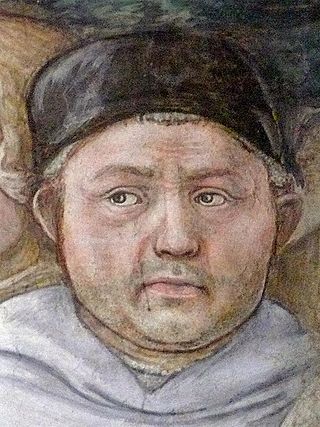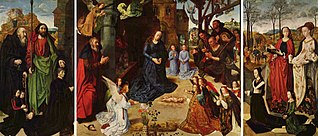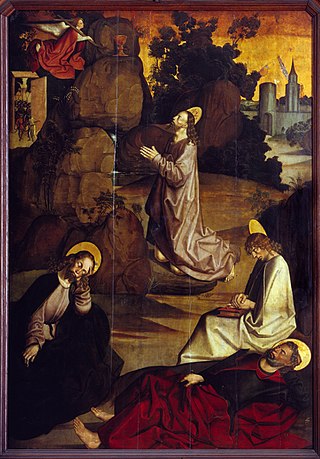This article has multiple issues. Please help improve it or discuss these issues on the talk page . (Learn how and when to remove these messages)
|

The Master of Liesborn was a Westphalian painter, of the fifteenth century, who remains anonymous.
This article has multiple issues. Please help improve it or discuss these issues on the talk page . (Learn how and when to remove these messages)
|

The Master of Liesborn was a Westphalian painter, of the fifteenth century, who remains anonymous.
In 1465 the unknown painter executed an altar-piece of note in the Benedictine Liesborn Abbey. His name is not mentioned by the historian of the monastery, who, however, declares that the Greeks would have looked on him as an artist of the first rank.
On the suppression of the monastery in 1807, the work was sold, divided into parts, and thus scattered. The principal parts, some of them fragmentary, are now to be found in the National Gallery, London, in the LWL-Landesmuseum für Kunst und Kulturgeschichte in Münster, the Museum of Fine Arts of Budapest and in private hands. A small number are displayed in the museum now open in part of the abbey's premises.
An idea of the altar-piece may be formed from a copy in a church at Lünen. The altar did not have folding wings, as was customary, but instead the paintings were placed side by side on a long panel. In the centre was the Redeemer on the Cross, with Mary on one side with Saints Cosmas and Damian, and on the other side Saints John, Scholastica and Benedict. Four angels caught the blood which poured from the wounds. The head of the Saviour is still preserved, as are the busts of the saints, and several angels with golden chalices. The background is also golden. Four scenes chosen from sacred history were reproduced on the sides.
The painting of the Annunciation represents a double apartment with vaulted ceiling, the front room being represented as an oratory and the other as a sleeping chamber: the marble floor, the damask curtains which surround the bed, a wardrobe, a bench some vases, and writing material, are all carefully drawn and with due regard for perspective; the arched doorway and the partition wall are adorned with figures of Prophets and Christ, and a representation of the world. The window looks out on a landscape. The Blessed Virgin, clad in a blue mantle over a robe of gold brocade, is seen in the front room turning from her prie-dieu towards the angel, who, richly robed and bearing in his left hand a sceptre, delivers his greeting. Of the Nativity group, there still remain five beautiful angels, who kneel on the ground around the effulgent form of the Child: there also remain two busts of male figures which were probably part of this scene. Of the "Adoration of the Magi" there remains only a single fragment. The "Presentation in the Temple" shows a venerable priest, to whom the Mother presents her Child laid on a white cloth: three witnesses surround the priest, while the mother is attended by two maidservants carrying the doves. Several panels have been lost.
The Liesborn artist is not as skilfully realistic as van Eyck, but his most characteristic claim to fame lies in the purity of his taste. The master's influence is evident in other works, but no second work can be attributed directly to him.
![]() This article incorporates text from a publication now in the public domain : Herbermann, Charles, ed. (1913). "The Master of Liesborn". Catholic Encyclopedia . New York: Robert Appleton Company.
This article incorporates text from a publication now in the public domain : Herbermann, Charles, ed. (1913). "The Master of Liesborn". Catholic Encyclopedia . New York: Robert Appleton Company.

Fra Angelico, O.P. was a Dominican friar and Italian Renaissance painter of the Early Renaissance, described by Giorgio Vasari in his Lives of the Artists as having "a rare and perfect talent". He earned his reputation primarily for the series of frescoes he made for his own friary, San Marco, in Florence, then worked in Rome and other cities. All his known work is of religious subjects.

The Ghent Altarpiece, also called the Adoration of the Mystic Lamb, is a very large and complex 15th-century polyptych altarpiece in St Bavo's Cathedral, Ghent, Belgium. It was begun around the mid-1420s and completed by 1432, and it is attributed to the Early Netherlandish painters and brothers Hubert and Jan van Eyck. The altarpiece is a prominent example of the transition from Middle Age to Renaissance art and is considered a masterpiece of European art, identified by some as "the first major oil painting."

Antonello da Messina, properly Antonello di Giovanni di Antonio, but also called Antonello degli Antoni and Anglicized as Anthony of Messina, was an Italian painter from Messina, active during the Italian Early Renaissance.

Pinturicchio, or Pintoricchio, also known as Benetto di Biagio or Sordicchio, was an Italian Renaissance painter. He acquired his nickname because of his small stature and he used it to sign some of his artworks that were created during the fifteenth and sixteenth centuries.

Filippo Lippi, also known as Lippo Lippi, was an Italian Renaissance painter of the Quattrocento and a Carmelite priest. He was an early Renaissance master of a painting workshop, who taught many painters. Sandro Botticelli and Francesco di Pesello were among his most distinguished pupils. His son, Filippino Lippi, also studied under him and assisted in some late works.

A panel painting is a painting made on a flat panel of wood, either a single piece or a number of pieces joined together. Until canvas became the more popular support medium in the 16th century, panel painting was the normal method, when not painting directly onto a wall (fresco) or on vellum. Wood panels were also used for mounting vellum paintings.

The Portinari Altarpiece or Portinari Triptych is an oil-on-wood triptych painting by the Flemish painter Hugo van der Goes, commissioned by Tommaso Portinari, representing the Adoration of the Shepherds. It measures 253 x 304 cm, and is now in the Galleria degli Uffizi in Florence, Italy. This altarpiece is filled with figures and religious symbols. Of all the late-fifteenth-century Flemish artworks, this painting is said to be the most studied.

Dieric Bouts was an Early Netherlandish painter. Bouts may have studied under Rogier van der Weyden, and his work was influenced by van der Weyden and Jan van Eyck. He worked in Leuven from 1457 until his death in 1475.

Neri di Bicci (1419–1491) was an Italian painter active in his native Florence. A prolific painter of mainly religious themes, he studied under his father, Bicci di Lorenzo, who had in turn studied under his father, Lorenzo di Bicci. The three thus formed a lineage of great painters that began with Neri's grandfather.
The Annunciation is an oil painting by the Early Netherlandish master Jan van Eyck, from around 1434–1436. The panel is housed in the National Gallery of Art in Washington, D.C. It was originally on panel but has been transferred to canvas. It is thought that it was the left (inner) wing of a triptych; there has been no sighting of the other wings since before 1817. The Annunciation is a highly complex work whose iconography is still debated by art historians. It was bought by the Tsar of Russia for the Hermitage Museum, but was sold by Stalin's government in 1930.
Master IW, also Monogramist I.W., was a Bohemian or Saxon Renaissance painter, trained in the workshop of Lucas Cranach the Elder, active between 1520 and 1550 mainly in north-west Bohemia.

The Master of the Saint Bartholomew Altarpiece was an Early Netherlandish painter active in Germany, mostly Cologne, between 1475/1480 and 1510. Despite his anonymity, he is one of the most recognizable artists of the early Renaissance period in German art.

The notname Master of the Aachen Altar is given to an anonymous late gothic painter active in Cologne between 1495 and 1520 or 1480 and 1520, named for his master work, the Aachen Altar triptych owned by the Aachen Cathedral Treasury. Along with the Master of St Severin and the Master of the legend of St. Ursula he is part of a group of painters who were active in Cologne at the beginning of the sixteenth century and were Cologne's last significant practitioners of late gothic painting.

The Kefermarkt altarpiece is a richly decorated wooden altarpiece in the Late Gothic style in the parish church of Kefermarkt in Upper Austria. Commissioned by the knight Christoph von Zelking, it was completed around 1497. Saints Peter, Wolfgang and Christopher are depicted in the central section. The wing panels depict scenes from the life of Mary, and the altarpiece also has an intricate superstructure and two side figures of Saints George and Florian.

The Cervara Altarpiece or Cervara Polyptych was an oil-on-oak-panel altarpiece painted by the Flemish painter Gerard David early in the 16th century for the high altar of Cervara Abbey in Liguria, Italy.

The Vyšší Brod (Hohenfurth) cycle, ranks among the most important monuments of European Gothic painting. It is made up of nine panel paintings depicting scenes from the Life of Christ, covering his childhood, Passion and resurrection. These paintings were made between 1345 and 1350 in the workshop of the Master of Vyšší Brod that was most probably based in Prague. The pictures were either meant for a square altar retable or else they decorated the choir partition of the church of the Cistercian Abbey in Vyšší Brod.

The Litoměřice Altarpiece was a large altar retable, in all likelihood with two pairs of movable wings and two pairs of fixed ones. From these wings, six panels have survived, two of which are painted on both sides. The movable wings on the left-hand side of the altar are presumed lost. The altar wing depicting Christ on the Mount of Olives belongs to the Diocese of Litoměřice, while the other panels are owned by the Regional Museum in Litoměřice. It is the largest surviving set of panel paintings by an anonymous late Gothic and early Renaissance painter called the Master of the Litoměřice Altarpiece. The altarpiece is part of the permanent collection of the North Bohemian Gallery of Fine Art in Litoměřice.

The Prague Altarpiece of Lucas Cranach the Elder portrays the Virgin Mary and female saints was, at the time it was made, the second most important altarpiece in St Vitus Cathedral. The altarpiece was most probably brought to Prague as a commission by Emperor Maximilian I. The reason for this could have been the betrothal of his granddaughter Mary to Louis II of Hungary, the engagement of Ferdinand I and Anna Jagiellon (1515) or the coronation of Mary of Habsburg as Queen of Bohemia (1522). A hundred years later, in 1619, the altarpiece fell victim to Calvinist iconoclasm. The figures of the female saints were cut out of it and its central part was destroyed.

The Marienaltar by Conrad von Soest is an altar retable in the Marienkirche in Dortmund from around 1420. It is considered a masterpiece of the late Gothic period and is a good example of the courtly style. Executed as a triptych, the retable is the painter's latest known work, completed shortly before his death. It is the main altar of the Dortmund church.
Master of the Chudenice Altarpiece was a Czech painter active in Prague at the turn of the late Gothic and early Renaissance.